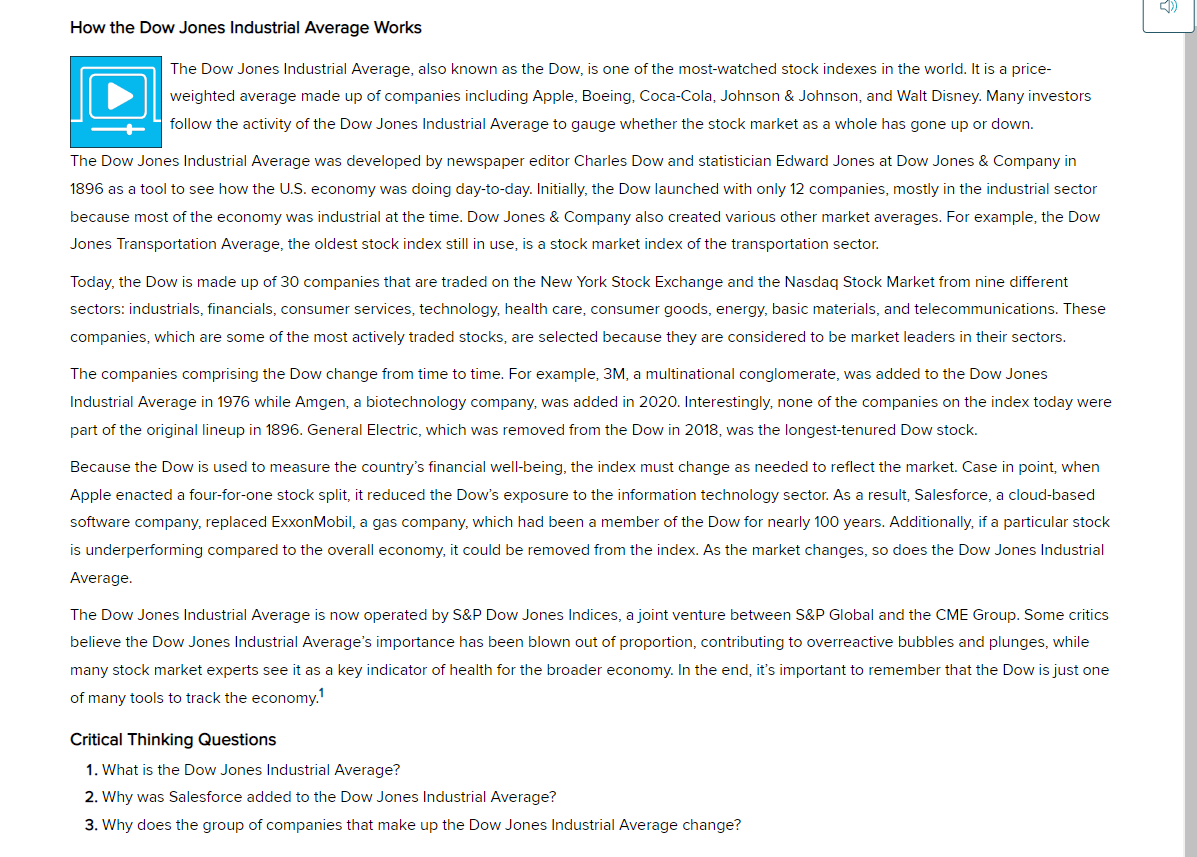Jones Transportation Average, the oldest stock index still in use, is a stock market index of the transportation sector. Today, the Dow is made up of 30 companies that are traded on the New York Stock Exchange and the Nasdaq Stock Market from nine different sectors: industrials, financials, consumer services, technology, health care, consumer goods, energy, basic materials, and telecommunications. These companies, which are some of the most actively traded stocks, are selected because they are considered to be market leaders in their sectors. The companies comprising the Dow change from time to time. For example, 3M, a multinational conglomerate, was added to the Dow Jones Industrial Average in 1976 while Amgen, a biotechnology company, was added in 2020. Interestingly, none of the companies on the index today were part of the original lineup in 1896. General Electric, which was removed from the Dow in 2018, was the longest-tenured Dow stock. Because the Dow is used to measure the country's financial well-being, the index must change as needed to reflect the market. Case in point, when Apple enacted a four-for-one stock split, it reduced the Dow's exposure to the information technology sector. As a result, Salesforce, a cloud-based software company, replaced ExxonMobil, a gas company, which had been a member of the Dow for nearly 100 years. Additionally, if a particular stock is underperforming compared to the overall economy, it could be removed from the index. As the market changes, so does the Dow Jones Industrial Average. The Dow Jones Industrial Average is now operated by S&P Dow Jones Indices, a joint venture between S&P Global and the CME Group. Some critics believe the Dow Jones Industrial Average's importance has been blown out of proportion, contributing to overreactive bubbles and plunges, while many stock market experts see it as a key indicator of health for the broader economy. In the end, it's important to remember that the Dow is just one of many tools to track the economy.¹ Critical Thinking Questions 1. What is the Dow Jones Industrial Average? 2. Why was Salesforce added to the Dow Jones Industrial Average? 3. Why does the group of companies that make up the Dow Jones Industrial Average change?
Jones Transportation Average, the oldest stock index still in use, is a stock market index of the transportation sector. Today, the Dow is made up of 30 companies that are traded on the New York Stock Exchange and the Nasdaq Stock Market from nine different sectors: industrials, financials, consumer services, technology, health care, consumer goods, energy, basic materials, and telecommunications. These companies, which are some of the most actively traded stocks, are selected because they are considered to be market leaders in their sectors. The companies comprising the Dow change from time to time. For example, 3M, a multinational conglomerate, was added to the Dow Jones Industrial Average in 1976 while Amgen, a biotechnology company, was added in 2020. Interestingly, none of the companies on the index today were part of the original lineup in 1896. General Electric, which was removed from the Dow in 2018, was the longest-tenured Dow stock. Because the Dow is used to measure the country's financial well-being, the index must change as needed to reflect the market. Case in point, when Apple enacted a four-for-one stock split, it reduced the Dow's exposure to the information technology sector. As a result, Salesforce, a cloud-based software company, replaced ExxonMobil, a gas company, which had been a member of the Dow for nearly 100 years. Additionally, if a particular stock is underperforming compared to the overall economy, it could be removed from the index. As the market changes, so does the Dow Jones Industrial Average. The Dow Jones Industrial Average is now operated by S&P Dow Jones Indices, a joint venture between S&P Global and the CME Group. Some critics believe the Dow Jones Industrial Average's importance has been blown out of proportion, contributing to overreactive bubbles and plunges, while many stock market experts see it as a key indicator of health for the broader economy. In the end, it's important to remember that the Dow is just one of many tools to track the economy.¹ Critical Thinking Questions 1. What is the Dow Jones Industrial Average? 2. Why was Salesforce added to the Dow Jones Industrial Average? 3. Why does the group of companies that make up the Dow Jones Industrial Average change?
Essentials of Business Analytics (MindTap Course List)
2nd Edition
ISBN:9781305627734
Author:Jeffrey D. Camm, James J. Cochran, Michael J. Fry, Jeffrey W. Ohlmann, David R. Anderson
Publisher:Jeffrey D. Camm, James J. Cochran, Michael J. Fry, Jeffrey W. Ohlmann, David R. Anderson
Chapter7: Linear Regression
Section: Chapter Questions
Problem 7P: The Dow Jones Industrial Average (DJIA) and the Standard Poors 500 (SP 500) indexes are used as...
Related questions
Question

Transcribed Image Text:How the Dow Jones Industrial Average Works
The Dow Jones Industrial Average, also known as the Dow, is one of the most-watched stock indexes in the world. It is a price-
weighted average made up of companies including Apple, Boeing, Coca-Cola, Johnson & Johnson, and Walt Disney. Many investors
follow the activity of the Dow Jones Industrial Average to gauge whether the stock market as a whole has gone up or down.
The Dow Jones Industrial Average was developed by newspaper editor Charles Dow and statistician Edward Jones at Dow Jones & Company in
1896 as a tool to see how the U.S. economy was doing day-to-day. Initially, the Dow launched with only 12 companies, mostly in the industrial sector
because most of the economy was industrial at the time. Dow Jones & Company also created various other market averages. For example, the Dow
Jones Transportation Average, the oldest stock index still in use, is a stock market index of the transportation sector.
Today, the Dow is made up of 30 companies that are traded on the New York Stock Exchange and the Nasdaq Stock Market from nine different
sectors: industrials, financials, consumer services, technology, health care, consumer goods, energy, basic materials, and telecommunications. These
companies, which are some of the most actively traded stocks, are selected because they are considered to be market leaders in their sectors.
The companies comprising the Dow change from time to time. For example, 3M, a multinational conglomerate, was added to the Dow Jones
Industrial Average in 1976 while Amgen, a biotechnology company, was added in 2020. Interestingly, none of the companies on the index today were
part of the original lineup in 1896. General Electric, which was removed from the Dow in 2018, was the longest-tenured Dow stock.
Because the Dow is used to measure the country's financial well-being, the index must change as needed to reflect the market. Case in point, when
Apple enacted a four-for-one stock split, it reduced the Dow's exposure to the information technology sector. As a result, Salesforce, a cloud-based
software company, replaced ExxonMobil, a gas company, which had been a member of the Dow for nearly 100 years. Additionally, if a particular stock
is underperforming compared to the overall economy, it could be removed from the index. As the market changes, so does the Dow Jones Industrial
Average.
The Dow Jones Industrial Average is now operated by S&P Dow Jones Indices, a joint venture between S&P Global and the CME Group. Some critics
believe the Dow Jones Industrial Average's importance has been blown out of proportion, contributing to overreactive bubbles and plunges, while
many stock market experts see it as a key indicator of health for the broader economy. In the end, it's important to remember that the Dow is just one
of many tools to track the economy.¹
Critical Thinking Questions
1. What is the Dow Jones Industrial Average?
2. Why was Salesforce added to the Dow Jones Industrial Average?
3. Why does the group of companies that make up the Dow Jones Industrial Average change?
✩
Expert Solution
This question has been solved!
Explore an expertly crafted, step-by-step solution for a thorough understanding of key concepts.
This is a popular solution!
Trending now
This is a popular solution!
Step by step
Solved in 3 steps

Knowledge Booster
Learn more about
Need a deep-dive on the concept behind this application? Look no further. Learn more about this topic, finance and related others by exploring similar questions and additional content below.Recommended textbooks for you

Essentials of Business Analytics (MindTap Course …
Statistics
ISBN:
9781305627734
Author:
Jeffrey D. Camm, James J. Cochran, Michael J. Fry, Jeffrey W. Ohlmann, David R. Anderson
Publisher:
Cengage Learning

Principles of Accounting Volume 1
Accounting
ISBN:
9781947172685
Author:
OpenStax
Publisher:
OpenStax College

Essentials Of Business Analytics
Statistics
ISBN:
9781285187273
Author:
Camm, Jeff.
Publisher:
Cengage Learning,

Essentials of Business Analytics (MindTap Course …
Statistics
ISBN:
9781305627734
Author:
Jeffrey D. Camm, James J. Cochran, Michael J. Fry, Jeffrey W. Ohlmann, David R. Anderson
Publisher:
Cengage Learning

Principles of Accounting Volume 1
Accounting
ISBN:
9781947172685
Author:
OpenStax
Publisher:
OpenStax College

Essentials Of Business Analytics
Statistics
ISBN:
9781285187273
Author:
Camm, Jeff.
Publisher:
Cengage Learning,

EBK CONTEMPORARY FINANCIAL MANAGEMENT
Finance
ISBN:
9781337514835
Author:
MOYER
Publisher:
CENGAGE LEARNING - CONSIGNMENT

Fundamentals of Financial Management, Concise Edi…
Finance
ISBN:
9781285065137
Author:
Eugene F. Brigham, Joel F. Houston
Publisher:
Cengage Learning

Fundamentals Of Financial Management, Concise Edi…
Finance
ISBN:
9781337902571
Author:
Eugene F. Brigham, Joel F. Houston
Publisher:
Cengage Learning